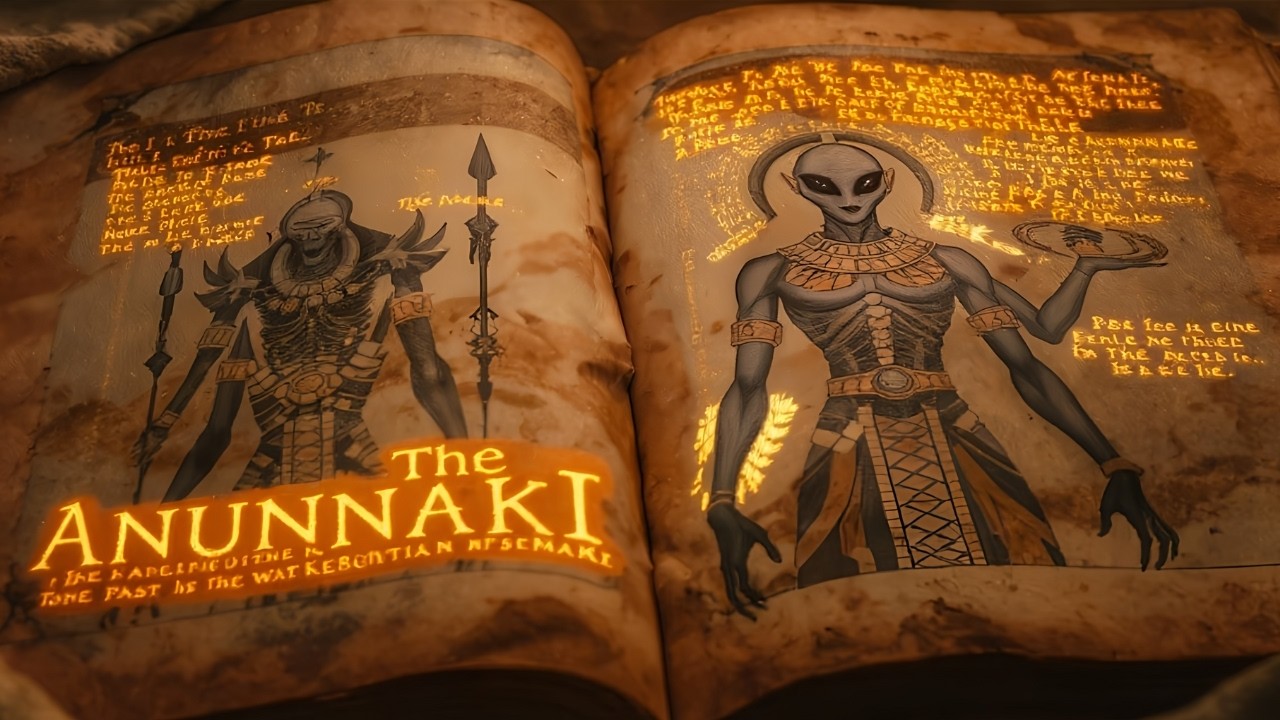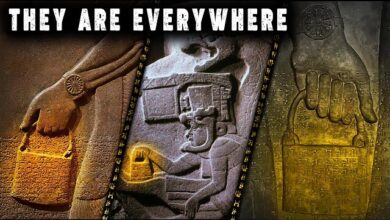Anunnaki Uncovered: Ancient Gods OR Alien Visitors?

Imagine one day you stumble upon ancient clay tablets, written thousands of years ago, recording beings of immense power who descended from the skies to Earth, teaching humanity science, mathematics, technology, and helping shape the course of civilization. It sounds like a Hollywood script, doesn’t it? Yet this is exactly what the ancient Sumerians inscribed on their clay tablets in a language that historians have spent decades deciphering.
The Sumerians lived from around 4500 to 1900 BCE in the region we know today as Iraq. They are regarded as humanity’s first true civilization, giving the world writing, an advanced mathematical system, complex laws, and incredibly precise astronomical knowledge. They built thriving cities like Ur and Uruk, constructed massive stepped temples known as ziggurats, and developed irrigation systems that transformed desert into fertile farmland. In other words, the Sumerians were not just ahead of their time; they laid foundations for knowledge still in use today.
However, what makes them truly mysterious—and fuels endless scholarly debates—are the detailed records of the Anunnaki. Ancient texts describe the Anunnaki as celestial beings with extraordinary knowledge who had direct contact with humans. These records suggest that they taught the Sumerians everything from astronomy and mathematics to agriculture and social governance—fields in which the Sumerians were remarkably advanced for their era.
Most mainstream historians argue that tales of the Anunnaki are purely mythological, symbolic stories meant to explain natural phenomena or provide spiritual guidance. Yet the level of detail and specificity in these accounts raises a provocative question: Were the Anunnaki merely divine symbols, or faint memories of real historical events—perhaps encounters with a highly advanced human civilization, or even something beyond our current understanding?
This video does not chase conspiracy theories, but instead delves into genuine archaeological discoveries: ancient clay tablets full of astonishing claims that historians still struggle to fully explain. Could the Anunnaki be nothing more than legendary gods, or might they be clues to a forgotten—or deliberately hidden—chapter of history?
To unravel the mystery of the Anunnaki, we must start with the Sumerian civilization, which flourished from around 4500 to 1900 BCE in Mesopotamia—the land between the Tigris and Euphrates rivers. Despite its hot, arid climate, the Sumerians not only survived but transformed the region into a prosperous land through sophisticated irrigation systems. They built vibrant cities like Ur, Uruk, and Eridu, filled with bustling markets, lively religious festivals, and monumental architecture.
Around 3200 BCE, the Sumerians invented humanity’s first writing system: cuneiform. Initially used for recording trade transactions and livestock counts, it later expanded to encompass laws, religious texts, and astronomical records. Thanks to these clay tablets, we gain invaluable insight into their world.
Beyond writing, the Sumerians excelled in mathematics and astronomy. They created a base-60 numerical system, which we still use today for measuring angles and time. They tracked planetary movements, distinguished planets from fixed stars, and recognized that Venus was both the Morning Star and the Evening Star—knowledge that took other cultures centuries to discover.
They also built monumental structures like ziggurats—massive stepped towers made of mud bricks, vividly painted and visible from afar. Additionally, the Sumerians invented the wheel, sewage systems, defensive city walls, and many innovations far ahead of their time.
Among the everyday records on clay tablets are mythological tales of cosmic battles, creation myths, and, notably, the appearance of the Anunnaki. Three prominent figures among the Anunnaki are Anu, Enlil, and Enki:
- Anu was considered the supreme deity, ruling the heavens, rarely intervening directly in human affairs but always watching.
- Enlil, Anu’s son, was a powerful, stern god associated with air, storms, and authority. He often interacted with humans and even unleashed great floods to punish humanity—a story reminiscent of the biblical flood.
- Enki, god of water, wisdom, and creation, was portrayed as compassionate, protecting humanity and teaching them agriculture, irrigation, construction, and metallurgy. In one legend, Enki devises a way to save humans from the flood that Enlil intended to bring.
The tablets also portray the Anunnaki as beings with very human emotions: arguing, jealousy, compassion, and regret. This leaves scholars wondering whether these stories are pure imagination—or reflections of some deeper, hidden reality.
Sumerian reliefs and cylinder seals sometimes depict humans standing beside figures who appear larger, wearing unusual garments, and wielding strange tools that look strikingly modern. This has fueled speculation that stories of the Anunnaki might be faint memories of contact with an advanced civilization—perhaps a group of humans from distant lands, rather than extraterrestrial beings.
Nonetheless, most scholars remain cautious. They believe the Sumerians achieved their astronomical knowledge through generations of careful observation, not through contact with “aliens.” Yet the astonishing precision of their records remains a puzzle: how could they calculate celestial movements and predict astronomical events without telescopes or modern technology?
Another theory suggests cultural diffusion: knowledge passed down from even older civilizations through trade, migration, or cultural exchanges. For instance, archaeologists discovered Göbekli Tepe in Turkey—a structure over 11,000 years old—proving that hunter-gatherer societies had far more advanced capabilities than previously thought. Could lost civilizations have left knowledge that eventually reached the Sumerians?
Of course, there’s also the bolder hypothesis: that the Anunnaki were extraterrestrial beings. This idea was popularized in the 20th century by author Zecharia Sitchin, who claimed the Anunnaki came from a planet called Nibiru. However, most Sumerian language experts reject this, arguing that Sitchin mistranslated and exaggerated ancient texts. Still, many remain fascinated by the possibility that “teachers” from the stars might have once shared knowledge with humanity.
Regardless of which theory is true, there’s no denying that the Sumerians left behind an extraordinary legacy of knowledge and art. The stories of the Anunnaki may be pure mythology—or they might hold clues to forgotten historical events. While mainstream scholars maintain a skeptical stance, the enduring mysteries hidden within these clay tablets continue to make us wonder: Could human history still have countless chapters left untold?
Talking about the Anunnaki means standing before thousands of ancient clay tablets, exquisite artifacts, and incredibly detailed stories. Yet the full picture of who they were is still missing countless pieces—and things get even more complicated when experts themselves can’t agree on what that completed puzzle should look like.
One of the biggest debates revolves around translation. Translating ancient texts is nothing like converting French or Spanish into English. Sumerian has not been spoken for thousands of years, and a single word can carry multiple meanings. Even small differences in how a word is translated can lead to completely opposite interpretations. For example, scholars still argue over the phrase describing the Anunnaki: does it literally mean “beings who descended from the heavens,” or is it just metaphorical language referring to royal lineage or divine favor? It’s a subtle difference, but one with enormous implications.
Closely tied to this debate is the name Zechariah Sitchin, arguably the most famous—and certainly the most controversial—figure in the field of Sumerian studies. He popularized the idea that the Anunnaki weren’t merely symbolic gods but extraterrestrial visitors who once came to Earth and shared advanced knowledge with humans. Although his books have captivated millions of readers, most mainstream scholars remain skeptical, arguing that Sitchin mistranslated or selectively interpreted texts to fit his theories. Yet his arguments continue to spark debate, highlighting how challenging it is to truly understand ancient languages.
Beyond translation, historians face another hurdle: gaps in the archaeological record. We rely on clay tablets and artifacts unearthed after being buried for thousands of years. Countless tablets have been damaged, lost, or still lie hidden beneath layers of sand and soil. Even the best-preserved tablets rarely tell a complete story. Imagine finding only a few torn pages from the middle of a book—with no cover and no ending—and having to guess the rest. That’s exactly the challenge archaeologists face.
Because of these fragmented clues, researchers often fiercely debate whether ancient texts should be interpreted literally. For instance, the Sumerians described planets and stars with astonishing precision, sometimes mentioning celestial bodies that humanity didn’t officially discover until modern times. Could they have truly known about planets invisible to the naked eye? In some clay tablets interpreted by Sitchin and others, there’s mention of a distant planet called Nibiru, supposedly orbiting the Sun far beyond our known planets. Mainstream astronomers strongly reject the existence of such a planet, yet they can’t deny that the Sumerians described cosmic phenomena that modern science only recognized thousands of years later. It’s genuinely puzzling and hard to dismiss outright.
Interestingly, even mainstream historians and researchers—those who dismiss alien theories—still acknowledge that the Sumerian clay tablets hold genuine mysteries. They tend to believe the Sumerians achieved their astronomical accuracy through generations of meticulous observation rather than help from “aliens.” Yet even the most skeptical scholars admit that some details remain extraordinarily hard to explain: how did ancient sky-watchers, without telescopes or modern tools, track planetary movements so precisely, record lunar cycles, and even predict astronomical events?
While researchers continue debating, there’s a reality that mainstream archaeology often seems cautious about diving deeply into these unanswered questions. It’s not due to any sinister conspiracy but rather the inherently conservative and careful nature of academic circles. In professional settings, theories that stray too far from established historical timelines risk being dismissed as fringe or unscientific. Historians and archaeologists rely heavily on evidence and rigorous methodology, so their caution is understandable. Yet one has to wonder: does that cautious approach sometimes cause us to miss promising avenues of research?
Consider the discovery of Göbekli Tepe. Before this site was uncovered a few decades ago, archaeologists firmly believed humans weren’t building complex structures 11,000 years ago. Yet the intricate stone pillars of Göbekli Tepe shattered that assumption, revealing that ancient human civilization may have been older and more advanced than we ever imagined. Could similar discoveries still lie hidden beneath the sands of Mesopotamia, waiting to rewrite history once again?
All of this leads to an essential question: Should we dismiss these ancient records entirely just because they’re difficult to interpret—or should we keep digging deeper? Archaeological history has shown that quickly rejecting unusual findings often leads humanity to overlook crucial clues. Many ideas once branded as crazy eventually became mainstream once more evidence emerged.
It’s also important to remember that the Sumerians didn’t view these stories as mere fairy tales. They were woven into the core of their lives, deeply connected to religious rituals, agriculture, and even city planning. Could this profound belief reflect some actual historical memory, however distorted or embellished over time?
Take another fascinating example: the Sumerian mathematical system based on the number 60. Today, using 60 might seem arbitrary, but it’s an incredibly practical system that simplifies complex calculations and angle measurements—especially important in astronomy. We still use remnants of it whenever we measure minutes, seconds, or divide circles into 360 degrees. Did the Sumerians invent this system entirely on their own, or did they inherit it from an even older civilization whose identity remains lost to us?
The idea of lost civilizations influencing the Sumerians isn’t as far-fetched as it might seem. History has repeatedly shown that cultures build upon the foundations of those that came before. Before the Greeks built their temples, the Egyptians built pyramids. Before the Egyptians, the Sumerians constructed ziggurats. So before the Sumerians, could there have been even older societies whose wisdom still lingers, hidden in these ancient myths?
Ultimately, we return to the core question: Why does mainstream archaeology seem hesitant to dig deeper into these mysteries? Part of it is scientific caution, avoiding theories easily labeled as sensational or pseudoscientific. Part of it is practical: without clear evidence, it’s hard to secure resources for further research. And another part may stem from the fear of fundamentally reshaping our understanding of human history. Rewriting textbooks, rethinking entire civilizations, and challenging long-held academic beliefs is no small task.
After exploring ancient clay tablets, unexpected archaeological discoveries, and the Sumerian myths that continue to baffle scholars, it’s clear that the Sumerians knew far more than we once believed. Their precise astronomical knowledge, complex mathematical systems, and tales of beings who descended from the heavens paint a captivating picture. But who were the Anunnaki, really? Were they actual gods who intervened in human history, merely symbolic figures, or possibly distorted memories of something even stranger?
In the end, it’s up to you to decide what to believe. The evidence is there, and even historians continue to debate the truth. Perhaps the most important message is this: Ancient history isn’t a closed book; it remains a living mystery, waiting to be explored. If these ancient tales truly conceal deeper secrets, what else might we have misunderstood? Who knows what secrets still lie buried beneath the sands, ready to rewrite everything we think we know about human history?
If you love diving into ancient mysteries, don’t hesitate to keep exploring. Because the deeper we look, the more one thing becomes clear: Human history may be far more extraordinary and surprising than we ever imagined.








